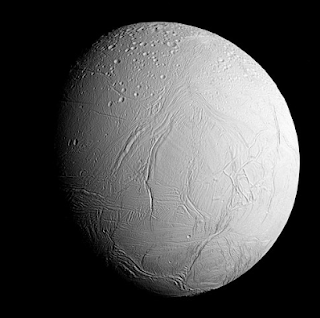Saturn has at least eighty two moons.Many of these moons look unusual and are very small.
Here is a list of the 7 largest moons of Saturn from smallest to largest.
Mimas
Enceladus
Tethys
Dione
Iapetus
Rhea
Titan
Number 7 Mimas was discovered in 1789 by William Herschel using a forty foot telescope. It has a diameter 396 kilometers and is composed mostly of water ice with only a small amount of rock.
A distinctive feature of this moon is a giant impact crater 130 km across, named Herschel.
The walls of this impact crater are up to 5 km high.
This moon along with several of the other Saturn moons has these weird crater chains.
Number 6 Enceladus is the sixth-largest moon of Saturn. It is about 500 kilometers in diameter
and is mostly covered by ice, making it one of the most reflective bodies of the Solar System.
Enceladus was discovered on August 28,1789, by William Herschel. A prominent feature is huge geysers of water on the south poles These geyser observations give evidence that this moon is geologically active.
Number 5 Tethys was discovered in 1684. This moon has a diameter slightly larger than 1000 kilometers.Tethys has the lowest density of all the major moons in the Solar System, indicating that it is made of water ice with just a small amount of rock. This moon has a huge impact crater named Odysseus, that is about 400 km in diameter.
Number 4 Dione was discovered in 1684 has a diameter of about 1123 kilometers.
Number 3 Iapetus was discovered in 1671 and has a diameter of 1470 kilometers. The low density of Iapetus indicates that it is mostly composed of ice, with only a small amount of rocky materials. One strange feature is that the leading hemisphere is dark and the trailing hemisphere is very bright.
Similar to the other Saturn moons it has large impact craters. A strange feature of Iapetus is the equatorial ridge that runs along the center.
Number 2 Rhea has a diameter of 1527 kilometers and discovered 1672 it is made up of ¼ rock and ¾ water. In 2008, NASA announced that Rhea may have a ring system. This would mark the first discovery of rings around a moon.
Number 1 Titan which has a diameter of 5149 km It was discovered in 1655. Titan is the largest moon of Saturn and the second-largest natural satellite in the Solar System. It is the only moon known to have a dense atmosphere, and the only known body in space, other than Earth, where clear evidence of stable bodies of surface liquid the liquid may be methane.
Related Links








0 comments:
Post a Comment